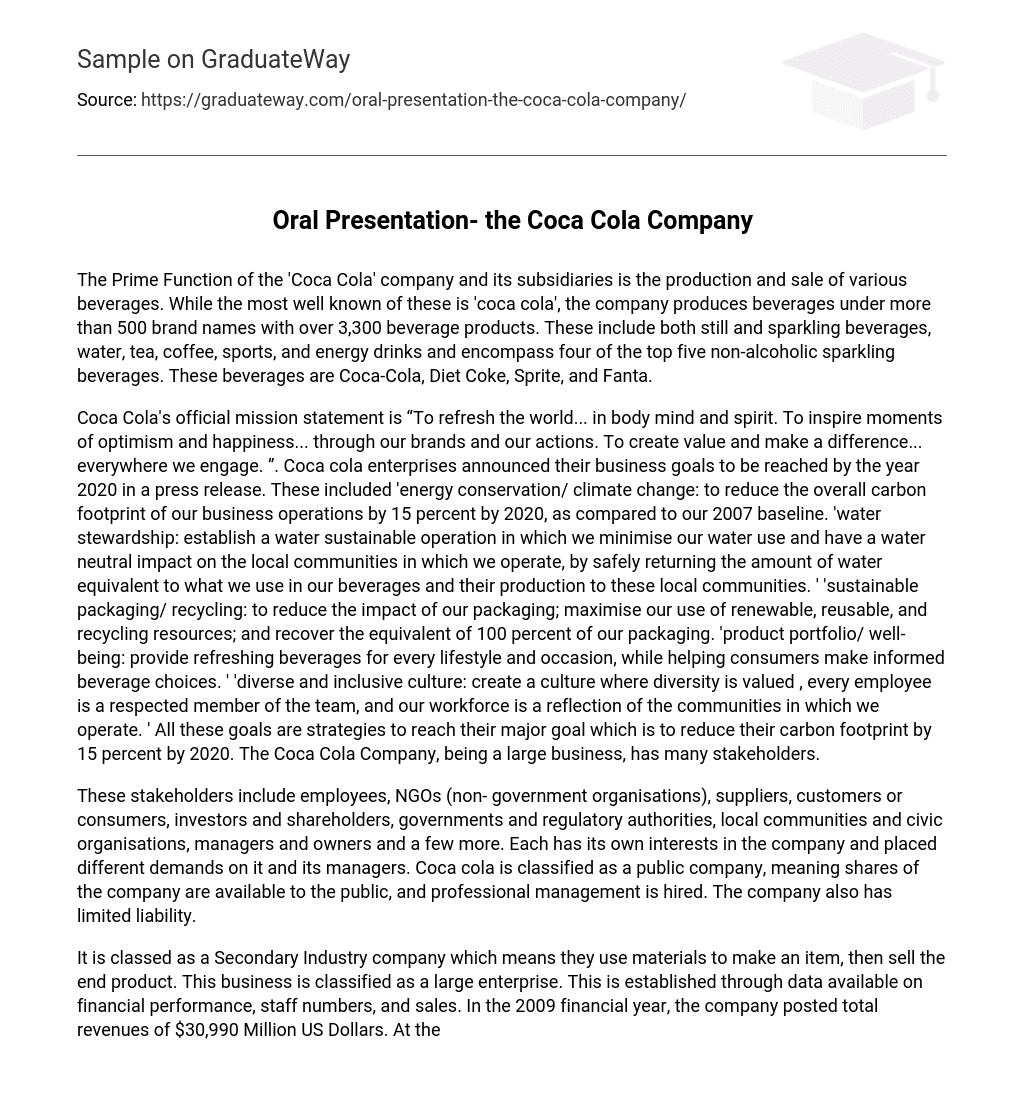The Prime Function of the ‘Coca Cola’ company and its subsidiaries is the production and sale of various beverages. While the most well known of these is ‘coca cola’, the company produces beverages under more than 500 brand names with over 3,300 beverage products. These include both still and sparkling beverages, water, tea, coffee, sports, and energy drinks and encompass four of the top five non-alcoholic sparkling beverages. These beverages are Coca-Cola, Diet Coke, Sprite, and Fanta.
Coca Cola’s official mission statement is “To refresh the world… in body mind and spirit. To inspire moments of optimism and happiness… through our brands and our actions. To create value and make a difference… everywhere we engage. ”. Coca cola enterprises announced their business goals to be reached by the year 2020 in a press release. These included ‘energy conservation/ climate change: to reduce the overall carbon footprint of our business operations by 15 percent by 2020, as compared to our 2007 baseline. ‘water stewardship: establish a water sustainable operation in which we minimise our water use and have a water neutral impact on the local communities in which we operate, by safely returning the amount of water equivalent to what we use in our beverages and their production to these local communities. ‘ ‘sustainable packaging/ recycling: to reduce the impact of our packaging; maximise our use of renewable, reusable, and recycling resources; and recover the equivalent of 100 percent of our packaging. ‘product portfolio/ well- being: provide refreshing beverages for every lifestyle and occasion, while helping consumers make informed beverage choices. ‘ ‘diverse and inclusive culture: create a culture where diversity is valued , every employee is a respected member of the team, and our workforce is a reflection of the communities in which we operate. ‘ All these goals are strategies to reach their major goal which is to reduce their carbon footprint by 15 percent by 2020. The Coca Cola Company, being a large business, has many stakeholders.
These stakeholders include employees, NGOs (non- government organisations), suppliers, customers or consumers, investors and shareholders, governments and regulatory authorities, local communities and civic organisations, managers and owners and a few more. Each has its own interests in the company and placed different demands on it and its managers. Coca cola is classified as a public company, meaning shares of the company are available to the public, and professional management is hired. The company also has limited liability.
It is classed as a Secondary Industry company which means they use materials to make an item, then sell the end product. This business is classified as a large enterprise. This is established through data available on financial performance, staff numbers, and sales. In the 2009 financial year, the company posted total revenues of $30,990 Million US Dollars. At the end of the 2009 financial reporting period, a total staff count of 92,800 was listed in their reports and total sales of more than 1. billion servings per day. The company has several advantages which have contributed to it’s ongoing success. These include such items as it’s ability to quickly respond to changes in customer tastes and requirements and an expanded, diversified product base. Reviewing the financial figures published on their web site, from 2006 to 2008 there has been a sustained growth in revenue of better than 10% per year up until 2009. In 2009 the revenue from the previous year fell by approximately $1,000 Million US Dollars.
It is most likely that this reduction in revenue can be attributed to the global financial crisis. When the crisis hit, disposable income for people was reduced and purchases of luxury items was the first victim of the reduced spending capacity. In a large number of cases, items such as soft-drink would have been included as a luxury item in many instances, resulting in the reduction in revenue. It is interesting to note that this occurred at the same time as the stock price remained steady, indicating that confidence in the company recovering from this down turn was high.





